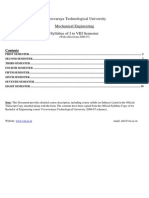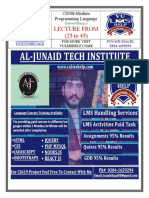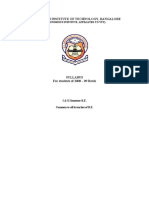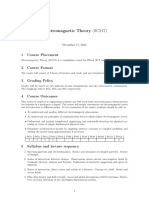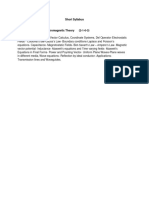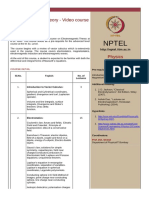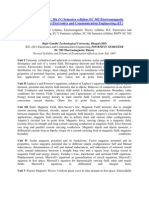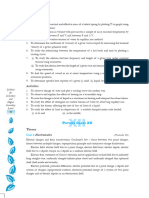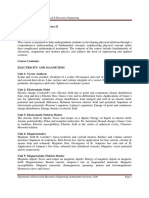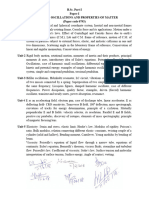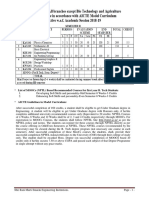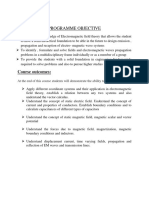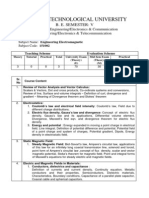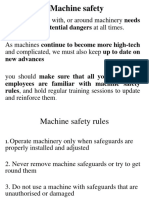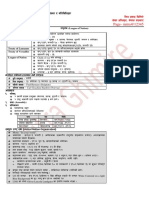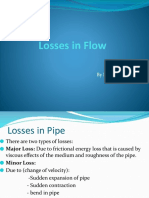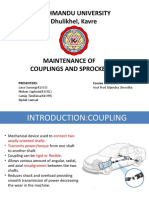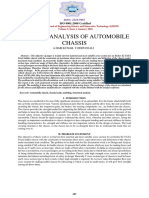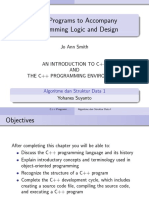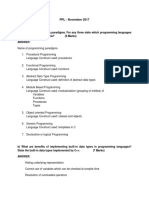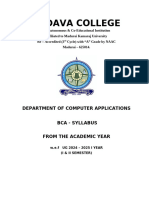First Year Second Semester: Department of Mechanical Engineering - Course Catalogue
First Year Second Semester: Department of Mechanical Engineering - Course Catalogue
Uploaded by
kapun kumar nayakCopyright:
Available Formats
First Year Second Semester: Department of Mechanical Engineering - Course Catalogue
First Year Second Semester: Department of Mechanical Engineering - Course Catalogue
Uploaded by
kapun kumar nayakOriginal Description:
Original Title
Copyright
Available Formats
Share this document
Did you find this document useful?
Is this content inappropriate?
Copyright:
Available Formats
First Year Second Semester: Department of Mechanical Engineering - Course Catalogue
First Year Second Semester: Department of Mechanical Engineering - Course Catalogue
Uploaded by
kapun kumar nayakCopyright:
Available Formats
First Year Second Semester
Department of Mechanical Engineering - Course Catalogue 1
MATH 201 Advanced Calculus 3cr.
Objective: To extend the first year calculus course and to equip students for the rigorous analysis
required for engineering studies.
Space Coordinates: cylindrical coordinates, equations relating Cartesian and cylindrical coordinates,
spherical coordinates, equations relating Cartesian and cylindrical coordinates to spherical, polar
coordinates graphs of polar equations, polar equations of conics and other curves, polar integrals.
Limits and Indeterminate Forms: the form 0.a, the form a.a, the forms 00, 0a, a0, aa, 1a, orders of
infinity.
Functions of Several Variables and Their Derivatives:
- functions of two or more variables, limits and continuity
- partial derivatives, chain rules, dependent variables
- gradients, directional derivative and tangent planes, higher order derivatives
- maxima, minima and saddle points, Lagrange multipliers, exact differentials.
Multiple Integrals:
- introduction, double integrals, area, changing to polar coordinates
- triple integrals in rectangular coordinates
- integrals in cylindrical and spherical coordinates
- surface area, change of order of integration.
Beta and Gamma Functions:
- Beta and Gamma functions, properties of the functions
- transformations of Gamma functions, relation between the functions.
Applications of the Theory of Integration:
- area of curves in Cartesian coordinates, area between two Cartesian curves
- area of the curves in polar coordinates, volume of solid of revolutions
- surface of solids of revolutions, Dirichlet's integrals.
Vector Functions and Their Derivatives:
- derivatives of vector functions, tangent vectors, velocity and acceleration
- arc length for space curves, the unit tangent vector
- curvature and normal vectors and components, derivatives of vector products,
Vector Integral Calculus:
- vector fields, surface integrals, line integrals and work, two dimensional fields
- flux across a plane curve, Green's theorem, Gauss's theorem, Stoke's theorem.
Fourier Series and Integrals:
- periodic functions, trigonometric series, Fourier series, Euler's formulae,
- convergence theorem ( proof not required ), functions having arbitrary period,- even and odd
functions, half-range expansions, Fourier integral.
References:
1. G B Thomas and R L Finney,Calculus and Analytic Geometry, Narosa Publishing House
2. E Kreyszig, Advanced Engineering Mathematics, Wiley Eastern Ltd.
Department of Mechanical Engineering - Course Catalogue 2
PHYS 102 General physics II 2cr.
A. Electricity & Magnetism
1. Electrostatic field
Electric charge; Coulomb's law; electric field due to point and continuous charge distribution; flux in
electric field; Gauss's law; electric field due to line, plane, and spherical charge distribution. Line
integral of an electric field; potential difference and potential; gradient of scalar field; relation between
electric field and potential; flux; divergence of vector field; Gauss divergence theorem; divergence in
Cartesian coordinates; divergence of electric field; Poisson's equation; Laplace’s equation; Curl of
vector function; Stokes’ theorem; curl in Cartesian coordinates; curl of electrostatic field; energy of point
and continuous charge distribution; energy density in electric field.
(10 hours)
2. Electrostatic field in matter
The electric field of dipole; force and torque on a dipole; energy of dipole in electric field; dielectric;
polarization; bound charges; field vectors D and E and their boundary conditions; capacitors filled with
dielectrics, electric susceptibility, polarizability, Clausius-Mossotti relation.
(4 hours)
3. Magnetostatics
Magnetic field B and magnetic flux; Lorentz's force; volume current density; equation of continuity; the
magnetic field of a steady current; Biot-Savart law; Ampere’s law; divergence and curl of B; magnetic
vector potential.
(4 hours)
4. Magnetostatic field in matter
Magnetic dipole; torque on magnetic dipole; energy of magnetic dipole in magnetic field; magnetization;
bound current; magnetic field vectors B and H and their relation; magnetic susceptibility;
diamagnetism, paramagneitsm and ferromagnetism; Langevin theory of diamagnetism and
paramagneitsm; domain theory of ferromagnetism; hysteresis.
(5 hours)
5. Electromagnetic induction
Motional emf; loop moving in static magnetic field; Faraday's law; Faraday’s lawin differential form;
self-induction; mutual induction; reciprocity theorem; energy stored in magnetic field.
(3 hours)
6. Electromagnetic wave propagation
Displacement current; Maxwell's equations; Maxwell’s equations in vacuum; Maxwell's equations in
material medium; energy in electromagnetic field; Poynting’s theorem and Poynting vector;
electromagnetic wave equation in vacuum.
(3 hours)
Department of Mechanical Engineering - Course Catalogue 3
PHYS 102 General physics II 2cr.
B. Modern Physics
1. Physics of atoms and molecules
Atomic spectra: visible and X-ray, Molecular bonds, Molecular spectra, Raman effect, Band theory of
solid, electrical conduction in metals, insulators and semiconductors, superconductivity. (3 hours)
2. Nuclear structure
Nuclear binding energy, Natural and artificial radioactivity, Nuclear reactions (3 hours)
3. Applications of nuclear physics
Nuclear fission and fusion, Nuclear reactors, Radiation detectors, Radiation hazards, Uses of nuclear
radiation. (3 hours)
Reference Books:
1. David J. Griffith: Introduction to electrodynamics
2. R. Resnick and E. Halliday: Physics part II
3. Berkley Physics Series: Electricity and magnetism
4. R. A. Serway and J. W. Jewett: Physics for engineers and scientists
5. R. Murugeshan: Modern physics
List of experiments
1. Measurement of low resistance using Carey-Foster's Bridge.
2. Determination capacitance of a capacitor by charging and discharging.
3. Study of the phenomenon of resonance in parallel LCR circuit.
4. Determination of wavelength of laser light using a plane diffraction grating.
5. Study of the absorption of beta-particles by an intervening medium and determination of
the mass absorption coefficient.
6. Determination of specific charge of an electron (e/m) by Thompson method.
7. Determination of moment of inertia of given fly wheel.
Department of Mechanical Engineering - Course Catalogue 4
COMP 116 Object Oriented Programming 2cr.
Course Description: This course introduces the fundamental concepts of object-oriented programming
Constructs in C++. Topics include classes, objects, inheritance, polymorphism and template etc.
Contents
Introduction to Object Oriented Programming[4 hours]: Concept of Object Oriented
Paradigm,Features of OOP, Benefits of OOP
Introducing C++ [4 hours]: Introduction,A sample C++ program, Reference Variables,Inline
Functions,Function Overloading,Comparison between C and C++
Classes and Objects [6 hours]: Introduction to class and objects, Defining a class with member
function, Private Member Functions,Initializing an Object,Static Data Members, Static Member
Functions
Object Constructions and Destructions [5 hours]: Introduction to Constructor, Parameterized
Constructor, Copy Constructor, Destructor
Operator Overloading [6 hours]: Introduction, Defining Operator Overloading, Overloading Unary
Operators, Overloading Binary Operators, Overloading Binary Operators using Friend Functions
Inheritance[6 hours]: Introduction, Base Classes and Derived Classes, Single Inheritance and Multiple
Inheritance, Protected Members, Virtual Base classes and Abstract classes, Constructors and
Destructor in Derived Classes
Polymorphism [6 hours]: Introduction, Pointers to Objects, Pointers to Derived Classes, Virtual
Functions, Pure Virtual Functions
Template [4 hours]: Introduction, Class Templates, Function Templates
Exception Handling [4 hours]: Introduction, Basics of Exception Handling, Exception Handling
Mechanism, Throwing and Catching Exception, Re-throwing an Exception
Total Lecture Hours: 45
Reference Books:
1. John R. Hubbard, “Theory and Problems of Programming with C++, 2/e”, McGraw-Hill.
2. H. M. Deitel, “C++ How to Program” D&D.
3. Friedman and Koffman, “Problem Solving, Abstraction and Design using C++ , 5/e”,
Addison-Wesley.
Department of Mechanical Engineering - Course Catalogue 5
ENGG 112 Elements of Engineering II 3cr.
Objective: This course is the fundamental course in electrical technology and covers the topics that is
applicable to the future professional to the all branches of engineering. It covers topics in basic circuit
analysis, A.C. circuit, transformers and electrical machines.
Basic Circuit Theory
Ideal and non-ideal sources, dependent and independent sources, resistors: characteristics (value,
power rating, codes, tolerances), current, voltage, power relationships, equivalent resistance in parallel
and series connection, temperature coefficient, delta-star connection, Kirchhoff’s current and voltage
laws, voltage divider and current divider formula, node and mesh analysis, solution by determinant and
substitution, superposition theorem, Thevenin’s and Norton’s theorems and network solution using
these theorems, maximum power transfer to the load in a 2 -port resistive network.
Transient Analysis
Terminal characteristics of inductor and capacitor, voltage current relationship in inductor and capacitor,
voltage and current across the capacitor and inductor in steady state, abrupt change of current or
voltage across capacitor or induction, energy stored in inductor and capacitor in steady state, inductors
and capacitors in series and parallel, source free and step response of RL and RC circuit.
AC Circuit Fundamentals
Generation of AC voltage (brief theoretical introduction of ac machine), definition of time period,
frequency, waveform, phase, and phase difference, peak, peak-to-peak, average, and RMS or effective
value of any type of ac voltage or current waveform, phasors: phasor algebra and steady state analysis
of RLC circuits, impedance, admittance, and reactance, real, reactive and apparent power, power factor
and significance of power factor, resonance in series and parallel RLC circuits, bandwidth, and effect of
Q-factor in resonance, 3-phase circuits: generation of 3-phase, merits of 3-phase over 1-phase
generation, phase sequence (ABC or CBA), voltage and current phasors in different sequence (ABC or
CBA), line and phase quantities in Y-connected or delta connected balanced load, Y-delta equivalence,
power in 3-phase circuits.
Magnetic Circuits and Transformers
Revision of electromagnetism, magnetic field and flux, magnetic field strength, MMF, permeability of
free space, relative permeability, B-H curve and its significance in the construction of electromechanical
energy conversion devices, introduction to a simple magnetic circuit with air gap, reluctance and
permeance, comparison of magnetic circuit with electric circuit, Faraday’s law of electromagnetic
induction, self inductance and mutual inductance, coupling coefficient, dot convention in electric circuit,
single phase transformers: construction, principle of operation, ideal transformer, voltage and current
Department of Mechanical Engineering - Course Catalogue 6
ENGG 112 Elements of Engineering II 3cr.
relationship, turns ratio, impedance transformation, losses, efficiency, and regulation, operation of relay
and solenoid.
Electrical Machines and Instruments
Basic principle of DC and AC machine (generator and motor), construction features, basic operation
principle, types, characteristics, principle of moving coil and moving iron galvanometer, principle of the
DC voltmeter, ammeter, and ohmmeter, voltmeter sensitivity and error correction.
Department of Mechanical Engineering - Course Catalogue 7
ENGT 102 Communication Skills 2cr.
Study Skills in English: (following selections from the textbook)
Units 4, 5, 6, and 7
- Seminar Skills
- English Composition : Theory and Practice
Adventures in English: (prescribed units)
a. Reading at four levels:
i. How sane are we? ii. Mr. Know- all
iii. Keeping errors at Bay iv. The Telegram on the table
v. We are breaking the silence about death vi. Where the mind is without fear
vii. A Tale viii. Who Was to Blame?
Professional Writing:
a. Research Essay b. Seminar c. Business Letters d. Report
Other language activities and games.
References
1. Nissani, Moti & Lohani, Shreedhar. Adventures in English. Nepal: Ekta Books, 1996.
2. Michael . J. Study Skills in English (Complete set). CUP. 1980.
Department of Mechanical Engineering - Course Catalogue 8
EDRG 102 Engineering Drawing 2cr.
Isometric Projection
Introduction, Isometric projection of different objects, orthographic projection.
Production drawing
Nominal and basic size, allowance, tolerance, limits of size, clearance fit, interference fit, basic hole
system and shaft system.
Screw threads
Representation and dimensions
Fasteners
Types and drawing representation of keys, cutter, joints, springs, bearings, bolt and nut. Rivet and
riveted joints- Types and representation.Section of solids.Intersection of solids.Development of
surfaces.
References
1. Fundamental of Engineering Drawing by W.J LUZADDER
2. Engg. Drawing and Graphic Technology by T.L. FRENCH
3. Engineering drawing volume 1&2 by K.R. GOPAL KRISHNA
4. Engineering drawing by M.D. BHAT
Department of Mechanical Engineering - Course Catalogue 9
ENGG 102 Engineering Project 2cr.
Guidelines
• The first few weeks of the course will be classroom basic instruction on the theoretical and
practical principles of digital logic design will be covered. This will be followed by instruction and
practical exercises on the skills of report writing and presentation.
• Students will then be divided into teams of six. They will appoint a team leader who wills co-
ordinate the activities of the team. An advisor will be allocated to each team.
• Each team will be guided into the selection of one of a number of projects involving
digital circuitry. Possible projects might be one of the following examples:- direction pointer. LED
chaser. 7-segment Display Driver .Reaction Tester Electronic Dice Traffic Lights. Encoder I.C.
Tester. Up/Down counter.
• Each team will be given a design specification which may include a block diagram. They will then
carry out the design. Prototype construction and testing of selected project.
• Each team will compile a report. Each student should make a contribution to the report. It should
include but not be limited to the following section:- introduction why the project was chosen and
what the aim was ). How it was carried out (who did what). Details of design and construction a
brief estimate of the costs involved. Test results (how well it met the specification). Lessons
learned from the project exercise and what modifications might be made for further development.
• Each term will give a presentation. Every member of the team should take part. Emphasis should
be making on giving a clear and concise overview of how the project was carried out Long and
detailed explanations of how the circuit works should be avoided. The team should use
appropriate resources such as white or chalk boards. Overhead projector charts etc. give a
demonstration of the produce and be prepared to questions. A maximum of half an hour will be
given for the presentation. This must not be exceeded. Each student will be assessed individually
for their presentation.
Department of Mechanical Engineering - Course Catalogue 10
ENGG 102 Engineering Project 2cr.
Fundamentals of Ecology
Organization, functioning and development, Concept of ecosystem, Organization of ecosystem:
abiotic and biotic component, Functioning of ecosystem: ecological energetic. Biogeochemical
cycles- N2, H 20,So2,P: homeostasis, Concept of limiting factors, Habitat and niche, Ecological
equivalents, Sympatry and Allopatry
Environmental Engineering
Introduction, Environmental system overview, Environmental ethics, A material balance approach
to problem solving, Environmental law, Environmental Economics
Hydrology
The hydrological cycle, Surface water hydrology, Ground water hydrology, Common units of
measurement, The hydrologic equation, Rainfall analysis, Runoff analysis
Water Quality management: Water pollutants and their sources, Water quality standard, Water
Quality Analysis, Water treatments,
Water Supply
Population estimation and Prediction, Consequence of overdrawing surface water and ground
water, Water Pollution- Nepalese context, Arsenic pollution in Nepal
Wastewater treatment: Wastewater microbiology, Characteristics of waste water, Municipal waste
water treatment system, Reed Bed Waste water treatment system
Air pollution
Physical and chemicals fundamentals, Air pollution perspectives, Air pollution standards, Effect of
air pollution, Air pollution meteorology, Atmospheric dispersion, Indoor air pollution, Control
measures, PM 10 – An analysis of Brick Kilns factory
Noise pollution
Introduction, Effect of noise on people, Rating system, Noise control
Solid waste management
Introduction, Sources, collection, transportation, landfilling, incineration and composting, Resource
conservation and recovery, Hazardous wastes
Global environmental events: Global warming, Ozone layer depletion, Acid deposition,
Eutrophication, Asian Brown Cloud,
Department of Mechanical Engineering - Course Catalogue 11
ENGG 102 Engineering Project 2cr.
Case study
Chernobyl disasters, Bhopal gas tragedy and Minamatta disease
Environmental mathematical modeling
Environmental technologies
Bioengineering, GIS and Remote Sensing, Instrumental Analysis
Observational studies
Air pollution monitoring in Kathmandu University, Water quality monitoring, Noise pollution,
Field trip
Bagmati waste water treatment KU Wastewater treatment, Dhulikhel Water Treatment Project
References
1. Odum, E.P. (1996) Fundamentals of Ecology, 3rd Edition, Natraj Publishers, Dehra Dun,
India.
2. Enger, E.D. and B. F. Smith (2000) Environmental Science: A Study of Interrelationships,
7th Ed., Mc Graw Hill Higher Education ,International Edition, Boston, USA.
3. Davis, M and David A. Cornell (1998) Introduction to environmental engineering.Third
edition, Mc Graw Hill International edition.
4. K. Subramanya (1994) Engineering hydrology, 2nd edition, Mc Graw Hill Publishing
Company Limited, New Delhi.
5. P. N. Modi (1998), Water Supply Engineering, Vol 1,Dr. P.N. Modi, Standard Book home,
Delhi.
Department of Mechanical Engineering - Course Catalogue 12
You might also like
- Syllabus Copy (I-VIII) Semester Vtu MechDocument44 pagesSyllabus Copy (I-VIII) Semester Vtu Mech''-Anoop Jm-''80% (5)
- Schaum's Outline of Electromagnetics, Fifth EditionFrom EverandSchaum's Outline of Electromagnetics, Fifth EditionRating: 4.5 out of 5 stars4.5/5 (2)
- CS508 SOLVED MCQs FINAL TERM BY JUNAIDDocument54 pagesCS508 SOLVED MCQs FINAL TERM BY JUNAIDkomal gurriya100% (1)
- Team C Pricing Strategy Case Draft #1Document5 pagesTeam C Pricing Strategy Case Draft #1kapun kumar nayakNo ratings yet
- Thinking in C++ 2nd Ed Volume 2Document458 pagesThinking in C++ 2nd Ed Volume 2Andrea BartilucciNo ratings yet
- Sem 6 SyllabusDocument20 pagesSem 6 SyllabusAkash SinghNo ratings yet
- Physics - Pastpaper For CssDocument12 pagesPhysics - Pastpaper For Cssdanyalhaider222333No ratings yet
- VTU Syllabus For Computer ScienceDocument14 pagesVTU Syllabus For Computer Scienceroshanpoudel21No ratings yet
- B.Tech 1st SemDocument15 pagesB.Tech 1st Semmrkhan.04565No ratings yet
- First YearDocument23 pagesFirst YearsaratknairNo ratings yet
- 4 Sem Electricity & MagnetismDocument4 pages4 Sem Electricity & Magnetism1singavarapusrichandraNo ratings yet
- EMT 2Document3 pagesEMT 2202404045No ratings yet
- Beee202l Electromagnetic-Theory TH 1.0 67 Beee202lDocument3 pagesBeee202l Electromagnetic-Theory TH 1.0 67 Beee202lNithish kumar RajendranNo ratings yet
- Syll Phy 12 17 05 2024Document5 pagesSyll Phy 12 17 05 2024aniketvideosytNo ratings yet
- Course E1 ECE (05-07-19)Document5 pagesCourse E1 ECE (05-07-19)Sravani SravsNo ratings yet
- Syllabus 1st Year VtuDocument0 pagesSyllabus 1st Year Vtuapi-238188038No ratings yet
- MTH102 Linear AlgebraDocument15 pagesMTH102 Linear AlgebraEisa MohdNo ratings yet
- Nptel: Electromagnetic Theory - Video CourseDocument3 pagesNptel: Electromagnetic Theory - Video CourseSiddharth Shankar RoutNo ratings yet
- Syllabus PH 5118 & 5218Document5 pagesSyllabus PH 5118 & 5218Findx proNo ratings yet
- Sem II SyllabusDocument8 pagesSem II Syllabusgurucharanmurmu904No ratings yet
- Course: Core Paper III - : SyllabusDocument2 pagesCourse: Core Paper III - : SyllabusAdhara MukherjeeNo ratings yet
- Syllabus CseDocument45 pagesSyllabus Csekaif04072004No ratings yet
- Applied Physics - CBSE SECONDARY SCHOOL 2016-17Document2 pagesApplied Physics - CBSE SECONDARY SCHOOL 2016-17Sandeep Kumar VRNo ratings yet
- MSC Physics 2024 PDFDocument7 pagesMSC Physics 2024 PDFashishthardak593No ratings yet
- Physics GE 3 & 4 TH Sem PDFDocument6 pagesPhysics GE 3 & 4 TH Sem PDFSurajit DasNo ratings yet
- EMT Syllabus.....Document2 pagesEMT Syllabus.....rg_0087No ratings yet
- BTech - Syllabus - newME 1st YearDocument20 pagesBTech - Syllabus - newME 1st Yearggrhg72No ratings yet
- B.Sc. II Semester UG Syllaqbus 2021-22 PhysicsDocument8 pagesB.Sc. II Semester UG Syllaqbus 2021-22 Physicsdjr012837No ratings yet
- Study Material 12th Physics 2023-24Document154 pagesStudy Material 12th Physics 2023-24ayusanupam100% (1)
- Emfw NotesDocument2 pagesEmfw NotesNaushad SheikNo ratings yet
- 03physics Xi Xii 1 6 11 - VPnN55nDocument6 pages03physics Xi Xii 1 6 11 - VPnN55ndaddyjiii8077No ratings yet
- Bachelor of Engineering in Electrical & Electronics EngineeringDocument2 pagesBachelor of Engineering in Electrical & Electronics EngineeringUtsav PathakNo ratings yet
- Ece1003 Electromagnetic-Field-Theory TH 2.1 47 Ece1003Document2 pagesEce1003 Electromagnetic-Field-Theory TH 2.1 47 Ece1003Sheikh NoumanNo ratings yet
- B.Sc. Part-I Paper-I Mechanics, Oscillations and Properties of Matter (Paper Code 0793)Document17 pagesB.Sc. Part-I Paper-I Mechanics, Oscillations and Properties of Matter (Paper Code 0793)playergghazlian173No ratings yet
- 1st Year B.tech 2022Document45 pages1st Year B.tech 2022arit4507No ratings yet
- B SC Physics SyllabusDocument17 pagesB SC Physics SyllabusKunalPandeyNo ratings yet
- Electromagnetic Feild Theory - EE315 - 14-07-2008Document2 pagesElectromagnetic Feild Theory - EE315 - 14-07-2008Iftikhar HussainNo ratings yet
- 1.syllabus (M.sc. Physics II)Document7 pages1.syllabus (M.sc. Physics II)Muhammad Hasan RazaNo ratings yet
- Important Theoretical TopicsDocument2 pagesImportant Theoretical Topicsshivamyadav076392No ratings yet
- 214 PhysicsDocument5 pages214 PhysicsezakbelachewNo ratings yet
- Nptel: Electromagnetic Theory - Video CourseDocument3 pagesNptel: Electromagnetic Theory - Video CourseNithya VelamNo ratings yet
- 142 SylDocument17 pages142 Sylk gNo ratings yet
- Damascus University Telecommunication Subject DescriptionDocument19 pagesDamascus University Telecommunication Subject DescriptionfearfreesNo ratings yet
- 7 BSC Sem VI 030920Document78 pages7 BSC Sem VI 030920mastermukulsharmaNo ratings yet
- IV B.E. (Electrical Engineering)Document8 pagesIV B.E. (Electrical Engineering)9y9aNo ratings yet
- SYLL_23-24_CL_XII_PHYSICSDocument6 pagesSYLL_23-24_CL_XII_PHYSICSxatson69No ratings yet
- 12 Physics Eng 2018 19 Vt3yayky8whjzzv7ryg1Document8 pages12 Physics Eng 2018 19 Vt3yayky8whjzzv7ryg1Aryan TejaanNo ratings yet
- Course Content & Grade: Branch Subject Title Subject CodeDocument2 pagesCourse Content & Grade: Branch Subject Title Subject CodeRakesh SohalNo ratings yet
- EE302 Electromagnetics - Image.Marked PDFDocument2 pagesEE302 Electromagnetics - Image.Marked PDFvishakhhariharanNo ratings yet
- SRMS ManualDocument41 pagesSRMS ManualHarshit SrivastavaNo ratings yet
- BSC Syllabus PhysicsDocument9 pagesBSC Syllabus PhysicsMax TNo ratings yet
- 5 6206075370165243477Document6 pages5 6206075370165243477pratiyaum98No ratings yet
- Emtl SyllabusDocument2 pagesEmtl SyllabusGanga Yadav CNo ratings yet
- Physics: Unit-I: Mathematical Physics and Classical MechanicsDocument3 pagesPhysics: Unit-I: Mathematical Physics and Classical Mechanicsjagadish duttaNo ratings yet
- EmtDocument3 pagesEmtArun KumarNo ratings yet
- ECE Sem 2 SyllabusDocument11 pagesECE Sem 2 SyllabusDaksh SharmaNo ratings yet
- Engineering ElectromagneticDocument2 pagesEngineering ElectromagneticAnandiacrNo ratings yet
- B SC - Physics PDFDocument35 pagesB SC - Physics PDFarunscribd20No ratings yet
- Physical Science SET SyllabusDocument4 pagesPhysical Science SET SyllabusNitinNo ratings yet
- BSC SyllabusDocument15 pagesBSC SyllabusNilasha GhoshNo ratings yet
- Syllabus (2020) : CSIR-NET Physical SciencesDocument12 pagesSyllabus (2020) : CSIR-NET Physical SciencesJaymin RayNo ratings yet
- Air Conditioning 3Document36 pagesAir Conditioning 3kapun kumar nayakNo ratings yet
- 1.2.2machine SafetyDocument34 pages1.2.2machine Safetykapun kumar nayakNo ratings yet
- L 5 - Chapter 3 2Document13 pagesL 5 - Chapter 3 2kapun kumar nayakNo ratings yet
- New Me-5Document3 pagesNew Me-5kapun kumar nayakNo ratings yet
- IC Engines AutomobilesDocument91 pagesIC Engines Automobileskapun kumar nayakNo ratings yet
- EarthingDocument32 pagesEarthingkapun kumar nayakNo ratings yet
- Non-Destructive TestingDocument38 pagesNon-Destructive Testingkapun kumar nayakNo ratings yet
- Lifting DevicesDocument28 pagesLifting Deviceskapun kumar nayakNo ratings yet
- UNO and Saarc PDFDocument18 pagesUNO and Saarc PDFkapun kumar nayakNo ratings yet
- Types of Machine ToolsDocument39 pagesTypes of Machine Toolskapun kumar nayak100% (1)
- TechnicalDocument20 pagesTechnicalkapun kumar nayakNo ratings yet
- FuelsDocument42 pagesFuelskapun kumar nayakNo ratings yet
- Diesel Power PlantDocument32 pagesDiesel Power Plantkapun kumar nayakNo ratings yet
- Types of PumpDocument32 pagesTypes of Pumpkapun kumar nayakNo ratings yet
- Maintenance BearingDocument26 pagesMaintenance Bearingkapun kumar nayakNo ratings yet
- Losses in FlowDocument30 pagesLosses in Flowkapun kumar nayakNo ratings yet
- Maintenance Presentation SlideDocument56 pagesMaintenance Presentation Slidekapun kumar nayakNo ratings yet
- AkesDocument103 pagesAkeskapun kumar nayakNo ratings yet
- Digital Logic Chap 4Document51 pagesDigital Logic Chap 4kapun kumar nayakNo ratings yet
- Maintenance CouplingSprocket FinalDocument38 pagesMaintenance CouplingSprocket Finalkapun kumar nayakNo ratings yet
- Maintenance of Gears and Gear DrivesDocument44 pagesMaintenance of Gears and Gear Driveskapun kumar nayak100% (2)
- Design & Analysis of Automobile Chassis: ISO 9001:2008 CertifiedDocument10 pagesDesign & Analysis of Automobile Chassis: ISO 9001:2008 Certifiedkapun kumar nayakNo ratings yet
- Name:Kapun Nayak DATE:12-02-2019 MR - Pratisthit L.Shrestha: Signature TitleDocument1 pageName:Kapun Nayak DATE:12-02-2019 MR - Pratisthit L.Shrestha: Signature Titlekapun kumar nayakNo ratings yet
- 2.4 FAC I L I TY Locat I ON: 1. Deciding On Domestic or International LocationDocument10 pages2.4 FAC I L I TY Locat I ON: 1. Deciding On Domestic or International Locationkapun kumar nayakNo ratings yet
- Ex:-Pitch Circle Drilling: Descriptio N N G M X Y Z I J K F S S P Q R T Abs Cords Metric Units 1st ToolDocument2 pagesEx:-Pitch Circle Drilling: Descriptio N N G M X Y Z I J K F S S P Q R T Abs Cords Metric Units 1st Toolkapun kumar nayakNo ratings yet
- Just 01 CPP HandoutDocument9 pagesJust 01 CPP HandoutYohanes SuyantoNo ratings yet
- IT Modular Curriculum 2005 Final EditedDocument153 pagesIT Modular Curriculum 2005 Final EditedTsegaye Andargie100% (1)
- Manual de Referencia APIDocument586 pagesManual de Referencia APIDavid BecerraNo ratings yet
- C Program Tricky ProgramsDocument9 pagesC Program Tricky ProgramsBhavya.Upadhyay Btech2019No ratings yet
- Pearson E.books-2017Document16 pagesPearson E.books-2017Anonymous Lf5zuYsNo ratings yet
- Syllabus MBA E-CommerceDocument34 pagesSyllabus MBA E-CommercetheabhaydubeyNo ratings yet
- C++ Templates Are Turing CompleteDocument3 pagesC++ Templates Are Turing CompletehackermawNo ratings yet
- CS101 Assignment 3Document6 pagesCS101 Assignment 3jkkcNo ratings yet
- Question Paper C++Document4 pagesQuestion Paper C++mediamcce_232011849100% (1)
- Practical C Plus Plus MetaprogrammingDocument54 pagesPractical C Plus Plus MetaprogrammingStefan StirbatNo ratings yet
- Sppu PPL Nov 2017 AnswersDocument15 pagesSppu PPL Nov 2017 Answersranjeetjagtap100% (1)
- For Job Updates and Free Materials Join Telegram: Wipro Interview QuestionsDocument7 pagesFor Job Updates and Free Materials Join Telegram: Wipro Interview QuestionsCseNo ratings yet
- bca syllabus 2024 - 2025 FINAL I YEAR (1)Document13 pagesbca syllabus 2024 - 2025 FINAL I YEAR (1)A.G.GOKUL SANKAR ASST. PROFESSORNo ratings yet
- UNIT-2: Classes and Object, Dynamic Constructor & Destructor BCA-2 SemDocument40 pagesUNIT-2: Classes and Object, Dynamic Constructor & Destructor BCA-2 Semroopashree obaleshNo ratings yet
- Chapter-1-Object Oriented ProgrammingDocument26 pagesChapter-1-Object Oriented ProgrammingJaikumar GuwalaniNo ratings yet
- Graphical Object-Oriented Programming in LabVIEWDocument13 pagesGraphical Object-Oriented Programming in LabVIEWNeneFINo ratings yet
- TouchGFX AtollicDocument14 pagesTouchGFX Atollichanifmohammed85No ratings yet
- Lecture 2Document35 pagesLecture 2Ali WaqasNo ratings yet
- M.1 - Intro To Smart Pointers and Move Semantics - Learn C++Document29 pagesM.1 - Intro To Smart Pointers and Move Semantics - Learn C++njb25bcnqfNo ratings yet
- Objective 6: Create A Linked List With Nodes Having Information About A Student. Insert A New Node at The Specified Position ProgramDocument8 pagesObjective 6: Create A Linked List With Nodes Having Information About A Student. Insert A New Node at The Specified Position Programr.adityaprakash.cse22No ratings yet
- Unit 3 - Procedural Abstraction and Functions That Return A ValueDocument57 pagesUnit 3 - Procedural Abstraction and Functions That Return A ValueCyril TrojilloNo ratings yet
- OOPs in C++ UNIT-IDocument135 pagesOOPs in C++ UNIT-IAnanya Gupta0% (1)
- 7 Constructors and DestructorsDocument24 pages7 Constructors and DestructorsUtsav VedantNo ratings yet
- Object-Oriented Programming (OOP)Document31 pagesObject-Oriented Programming (OOP)Ahmed AshrafNo ratings yet
- Java Unit 1Document40 pagesJava Unit 1K VENKATA SRAVANINo ratings yet
- C++ AssignmentDocument19 pagesC++ AssignmentAvinash DasNo ratings yet
- How Can I Learn C++ QuicklyDocument218 pagesHow Can I Learn C++ QuicklyMathewsNo ratings yet
- Chapter 6: User-Defined Functions I: Programming For Engineers 1Document33 pagesChapter 6: User-Defined Functions I: Programming For Engineers 1AbdelrahmanJamalNo ratings yet
